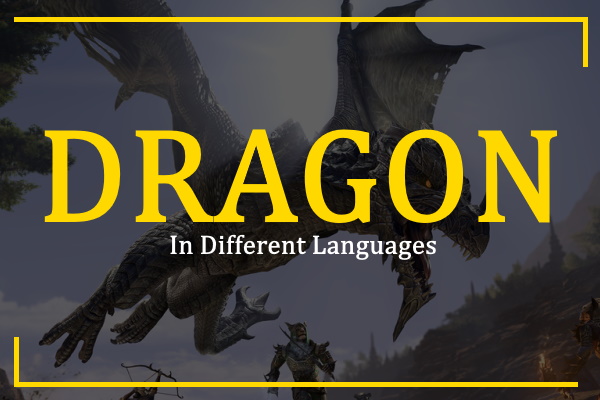Table of Contents
Dragon in Different Languages: A dragon is a huge, mythical serpentine creature which is found throughout the world in the folklore of many cultures. Dragons vary dramatically according to area, but dragons have often been described as winged, horned, four-legged and breathable in the western cultures of the High Middle Ages.
Dragon in All Languages
Translation of word Dragon in almost 100+ different languages of the world.
| Different Languages | Word Dragon |
|---|---|
| Albanian | dragua |
| Basque | dragoi |
| Belarusian | цмок |
| Bosnian | zmaj |
| Bulgarian | дракон |
| Catalan | drac |
| Croatian | zmaj |
| Czech | drak |
| Danish | trække på |
| Dutch | draak |
| Estonian | draakon |
| Finnish | lohikäärme |
| French | dragon |
| Galician | dragón |
| German | Drachen |
| Greek | δράκων (drákon) |
| Hungarian | sárkány |
| Icelandic | Dreki |
| Irish | Dragon |
| Italian | Drago |
| Latvian | pūķis |
| Lithuanian | drakonas |
| Macedonian | змеј |
| Maltese | Dragun |
| Norwegian | drage |
| Polish | smok |
| Portuguese | Dragão |
| Romanian | balaur |
| Russian | Дракон (Drakon) |
| Serbian | змај (zmaj) |
| Slovak | drak |
| Slovenian | zmaj |
| Spanish | dragón |
| Swedish | drake |
| Ukrainian | дракон (drakon) |
| Welsh | dragon |
| Yiddish | דראַקאָן |
| Armenian | թեվավոր մողես |
| Azerbaijani | əjdəha |
| Bengali | ঘুড়ি বিশেষ |
| Chinese Simplified | 龙 (lóng) |
| Chinese Traditional | 龍 (lóng) |
| Georgian | dragon |
| Gujarati | ડ્રેગન |
| Hindi | अजगर |
| Hmong | zaj |
| Japanese | ドラゴン |
| Kannada | ಡ್ರ್ಯಾಗನ್ |
| Kazakh | айдаһар |
| Khmer | នាគ |
| Korean | 용 (yong) |
| Lao | ມັງກອນ |
| Malayalam | ഡ്രാഗൺ |
| Marathi | ड्रॅगन |
| Mongolian | луу |
| Myanmar (Burmese) | နဂါး |
| Nepali | ड्रागन |
| Sinhala | මකරා |
| Tajik | аждаҳор |
| Tamil | டிராகன் |
| Telugu | డ్రాగన్ |
| Thai | มังกร |
| Turkish | Ejderha |
| Urdu | ڈریگن |
| Uzbek | ajdar |
| Vietnamese | Rồng |
| Arabic | تنين (tanin) |
| Hebrew | דְרָקוֹן |
| Persian | اژدها |
| Afrikaans | draak |
| Chichewa | chinjoka |
| Hausa | dragon |
| Igbo | dragon |
| Sesotho | drakone |
| Somali | masduulaagii |
| Swahili | joka |
| Yoruba | dragoni |
| Zulu | dragon |
| Cebuano | dragon |
| Filipino | Dragon |
| Indonesian | naga |
| Javanese | dragon |
| Malagasy | dragona |
| Malay | naga |
| Maori | tarakona |
| Esperanto | drako |
| Haitian Creole | dragon |
| Latin | draco |
Dragon in European Languages
Translation of word Dragon in almost 42 European languages.
| Different Languages | Word Dragon |
|---|---|
| Albanian | dragua |
| Basque | dragoi |
| Belarusian | цмок |
| Bosnian | zmaj |
| Bulgarian | дракон |
| Catalan | drac |
| Corsican | drago |
| Croatian | zmaj |
| Czech | drak |
| Danish | trække på |
| Dutch | draak |
| Estonian | draakon |
| Finnish | lohikäärme |
| French | dragon |
| Frisian | draak |
| Galician | dragón |
| German | Drachen |
| Greek | δράκων [drákon] |
| Hungarian | sárkány |
| Icelandic | Dreki |
| Irish | Dragon |
| Italian | Drago |
| Latvian | pūķis |
| Lithuanian | drakonas |
| Luxembourgish | Draach |
| Macedonian | змеј |
| Maltese | Dragun |
| Norwegian | drage |
| Polish | smok |
| Portuguese | Dragão |
| Romanian | balaur |
| Russian | Дракон [Drakon] |
| Scots Gaelic | dràgon |
| Serbian | змај [zmaj] |
| Slovak | drak |
| Slovenian | zmaj |
| Spanish | dragón |
| Swedish | drake |
| Tatar | аждаһа |
| Ukrainian | дракон [drakon] |
| Welsh | dragon |
| Yiddish | דראַקאָן |
Dragon in Asian Languages
Translation of word Dragon in almost 36 Asian languages.
| Different Languages | Word Dragon |
|---|---|
| Armenian | թեվավոր մողես |
| Azerbaijani | əjdəha |
| Bengali | ঘুড়ি বিশেষ |
| Chinese Simplified | 龙 [lóng] |
| Chinese Traditional | 龍 [lóng] |
| Georgian | dragon |
| Gujarati | ડ્રેગન |
| Hindi | अजगर |
| Hmong | zaj |
| Japanese | ドラゴン |
| Kannada | ಡ್ರ್ಯಾಗನ್ |
| Kazakh | айдаһар |
| Khmer | នាគ |
| Korean | 용 [yong] |
| Kyrgyz | ажыдаар |
| Lao | ມັງກອນ |
| Malayalam | ഡ്രാഗൺ |
| Marathi | ड्रॅगन |
| Mongolian | луу |
| Myanmar (Burmese) | နဂါး |
| Nepali | ड्रागन |
| Odia | ଡ୍ରାଗନ୍ |
| Pashto | ډریگن |
| Punjabi | ਅਜਗਰ |
| Sindhi | ڊريگن |
| Sinhala | මකරා |
| Tajik | аждаҳор |
| Tamil | டிராகன் |
| Telugu | డ్రాగన్ |
| Thai | มังกร |
| Turkish | Ejderha |
| Turkmen | aagondarha |
| Urdu | ڈریگن |
| Uyghur | ئەجدىھا |
| Uzbek | ajdar |
| Vietnamese | Rồng |
Dragon in Middle East Languages
Translation of word Dragon in 4 middle eastern languages.
| Different Languages | Word Dragon |
|---|---|
| Arabic | تنين [tanin] |
| Hebrew | דְרָקוֹן |
| Kurdish (Kurmanji) | zîha |
| Persian | اژدها |
Dragon in African Languages
Translation of word Dragon in almost 13 African languages.
| Different Languages | Word Dragon |
|---|---|
| Afrikaans | draak |
| Amharic | ዘንዶ |
| Chichewa | chinjoka |
| Hausa | dragon |
| Igbo | dragon |
| Kinyarwanda | Ikiyoka |
| Sesotho | drakone |
| Shona | dhiragoni |
| Somali | masduulaagii |
| Swahili | joka |
| Xhosa | inamba |
| Yoruba | dragoni |
| Zulu | dragon |
Dragon in Austronesian Languages
Translation of word Dragon in almost 10 Austronesian languages.
| Different Languages | Word Dragon |
|---|---|
| Cebuano | dragon |
| Filipino | Dragon |
| Hawaiian | deragona |
| Indonesian | naga |
| Javanese | dragon |
| Malagasy | dragona |
| Malay | naga |
| Maori | tarakona |
| Samoan | tarako |
| Sundanese | naga |
Dragon in Other Foreign Languages
| Different Languages | Word Dragon |
|---|---|
| Esperanto | drako |
| Haitian Creole | dragon |
| Latin | draco |
Video Translation of Dragon in 10 Other Languages
Coming Soon…
More Information about Dragon
Dragons in Eastern cultures are usually portrayed as wingless, four-legged, excessively intelligent, serpentine beings.
The trust in these living beings seemed to emerge from the ancients of a dragon-like, prehistoric giant reptile without the least knowledge.
Read Also:
The term “drakōn” in Greece was originally used for any large serpent (see the sea snake), and the mythological dragon remained essentially a snake, whatever form it later got adopted.
Commodities among dragon features includes snakelike characteristics, reptilian skin, four legs with 3 or 4 toes each, the spinal nodes running down the back, a tail, and a tight jaw with rows of teeth, and are often a hybridisation of the avian, feline, reptile features.
Some modern scholars think that large crocodiles, extinct and moving, have the nearest likened and most probable analog of the current dragon imagery when they are found in forest or wetland.
The outline of the dragon differed from the beginning. The Chaldean Dragon Tiamat had four arms, a scaly corpse and wings, while the Biblical Dragon of Revelation, the “old dragon,” was like the Greek Hydra with multiple heads.
Dragons were used as warlike emblems at an early stage, because they not only had defensive and terrorist attributes, but also had aesthetic effects.
The faith in dragons was founded not only in the legend, but at least in hard evidence, or so long ago.
For thousands of years no one understood what to do about the giant bones which have sometimes been found around the globe, and for people who do not know dinosaurs, dragons seemed normal.
Scholars think that dragons’ fire-respiring dimension comes from medieval mouth-representations. Hell’s entrance was often portrayed as a literal mouth of a demon, which was marked by the flames and smoke of Hades.
The correlation is very natural if you believe not just in the literal life of hell, but in the actual nature of dragons as Demonic. Dragons are just humanly portrayed, and they never existed physically.

Arslan Hussain, founder of The Different Languages, is an experienced translator passionate about languages and cultures. Through his website, he shares his knowledge and love for different languages, making learning accessible and enjoyable.

